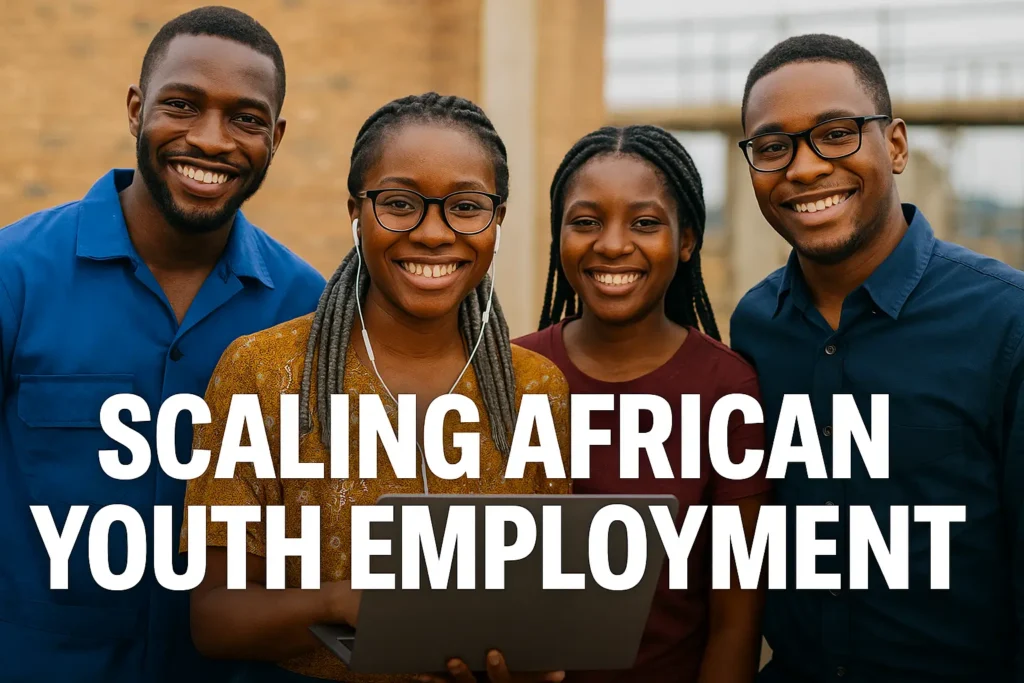How can more jobs be created for young people in Africa when the working-age population is growing at an unprecedented pace? This is one of the most pressing questions for governments, businesses, and international organizations.
According to the World Bank, Africa will have more than 830 million young people entering the labor market by 2050. This demographic growth represents both a tremendous opportunity and a colossal challenge: if well managed, it can transform the continent into a global economic engine; if mismanaged, it risks fueling unemployment, migration, and inequality.
The concept of Scaling African Youth Employment aims to move from isolated programs to massive strategies that combine training, digitalization, and public-private partnerships. In this article, we answer the most frequently asked questions: What does it mean in practice? Which sectors are creating the most jobs? What tools already exist? And most importantly, how can African talent access both local and international opportunities?
What does “Scaling African Youth Employment” mean?
Scaling African Youth Employment means implementing solutions that create millions of jobs quickly and sustainably for young Africans. The goal is not to multiply small initiatives, but to build programs capable of reaching hundreds of thousands of beneficiaries every year.
Concretely, this involves:
- Digitalizing training and support programs.
- Partnering with global companies to open up access to remote jobs.
- Supporting local entrepreneurship, which drives 80% of jobs in Africa (source: African Development Bank).
According to the International Labour Organization (ILO), Africa needs to create 25 million jobs per year by 2030 to absorb new labor market entrants.
Why is youth employment crucial for Africa?
Because young people are the continent’s greatest resource. Today, 60% of Africa’s population is under 25 years old (UN, 2024). If this energy is properly harnessed, it can become a major competitive advantage.
The key issues are:
- Reducing unemployment: youth unemployment averages 13% but exceeds 30% in some countries.
- Preventing brain drain: each year, more than 70,000 African graduates leave their countries due to a lack of local opportunities.
- Driving growth: according to McKinsey, a fully employed Africa could account for a quarter of global growth by 2040.
In short: Africa’s future and economic stability depend on youth employment.
Which sectors create the most jobs for African youth?
Several sectors are identified as priorities:
1. Digital and remote work
- Freelancing platforms and outsourcing already provide opportunities to thousands of young people.
- According to IFC, Africa’s freelance market could reach $300 billion by 2030.
2. Modernized agriculture
- Agriculture remains the continent’s largest employer (55% of jobs).
- Agri-tech, drones, and smart irrigation are creating new, more skilled career paths.
3. Renewable energy
- Africa is becoming a hub for solar and wind power.
- This sector could generate 4 million green jobs by 2030 (IRENA, 2023).
4. Health and education
- Population growth drives massive demand for doctors, nurses, and teachers.
- The digitalization of these services (telemedicine, e-learning) adds further opportunities.
How does digitalization help scale employment?
Digitalization is a key accelerator for scaling. With more than 570 million Internet users in Africa (Statista, 2024), online platforms are powerful tools for connecting young people to opportunities.
Concrete examples include:
- Talent matching platforms (such as Breedj, Andela, Talenteum) linking international companies with qualified African workers.
- Online bootcamps offering rapid training in digital skills (web development, data science, digital marketing).
- AI tools to optimize job search, CV writing, and career guidance.
Thanks to these innovations, a young person in Abidjan can work for a startup in Paris or San Francisco without leaving their country.
What obstacles still need to be overcome?
Even with huge potential, several barriers remain:
- Limited infrastructure: still 40% of Africans lack Internet access (GSMA, 2024).
- Lack of funding: less than 5% of global venture capital is invested in Africa.
- Skills mismatch: nearly 50% of employers report not finding locally qualified profiles.
- Legal frameworks: recognition of remote work and freelancing is still limited in some countries.
These challenges show that scaling youth employment requires an integrated approach: public policy, private sector, and technological innovation.
What concrete initiatives already exist?
Several programs are already underway:
- Mastercard Foundation – Young Africa Works: aims to create 30 million jobs by 2030.
- Andela: has already placed more than 4,000 African developers with global companies.
- Breedj.com: offers a talent marketplace with employer of record solutions, enabling companies to easily recruit in Africa.
- Business Africa: brings together African employers’ organizations to promote jobs and training.
These initiatives prove that it is possible to achieve large-scale impact.
Scaling African Youth Employment is not an option, but a necessity. With a rapidly expanding youth population and a global market in need of skilled workers, Africa has a major card to play. Key sectors such as digital, modernized agriculture, green energy, and healthcare already hold the potential for millions of jobs.
Success will require massive investment in training, digital infrastructure, and public-private partnerships. Talent platforms like Breedj show that it is possible to connect African youth with global opportunities while generating local impact.
The question is no longer whether Africa can employ its youth, but how to accelerate the scale-up process. The answer lies in innovation, cooperation, and an ambitious vision.
👉 If you are a company looking for motivated, skilled talent, Africa is the talent pool you should start exploring today.














